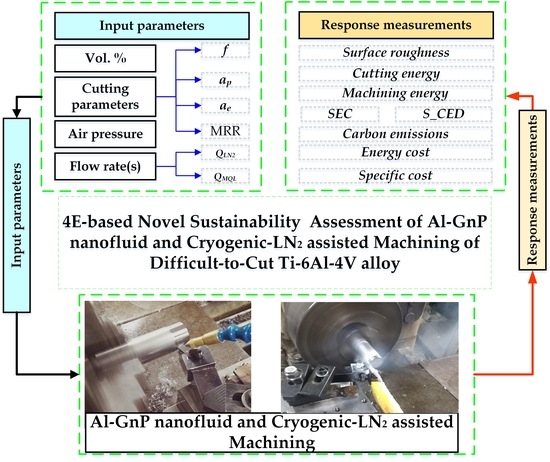Energy, Environmental, Economic, and Technological Analysis of Al-GnP Nanofluid- and Cryogenic LN2-Assisted Sustainable Machining of Ti-6Al-4V Alloy
Abstract
1. Introduction
2. Literature Review
2.1. Energy Consumption
2.2. Environmental Burden
2.3. Production Cost
2.4. Cooling and Lubrication Approaches
3. Empirical Models for Sustainable Indicators
4. Experimentation
4.1. Work Material and Tooling
4.2. Hybrid Cooling and Lubrication Approaches
4.3. Experimental Procedure and Measurements
4.4. Data Inventory
5. Results and Discussion
5.1. Selection of Optimal Levels of Input Parameters
5.2. Mechanism of Nanofluid and Cryogenic Cooling
- Hybrid nanofluids (variable-sized nano-additives) enhanced the performance of nanofluids behaving as spacers between the tool–workpiece contact interface.
- Hybrid nanofluids atomized through the MQL mist containing nano-additives and air mixture formed a thin tribo-film on the tool and workpiece surface to enhance the tribological characteristics.
- Hybrid nanofluids have the capability to penetrate well inside narrow surfaces, preventing rubbing of two surfaces [44].
- Fine dissolution of nano-additives is a challenging task.
- Nanoparticles enter our skin, cause allergies, and have a negative impact on plant growth and seeds.
- Nanoparticles are difficult to detect if opened in the air. Therefore, a hazard appraisal should also be reported to underscore the danger associated with the particles.
- Cryogenic materials having extremely low temperature touch the workpiece and evaporate without leaving a residue.
- The self-generated high pressure does not require external pressure.
- Quick evaporation also keeps the workpiece cold and does not affect the surrounding, creating space for the new coolant.
- Furthermore, cryogenic coolants are sustainable in machining and also improve machining under harsh cutting conditions [45].
- The Leidenfrost effect of cryogenic nitrogen also helps to improve the process efficiency.
5.3. Surface Quality
5.4. Power and Energy Consumption
5.5. Environmental Impacts
5.6. Production Cost
6. Overall Comparison of Cooling/Lubrication Approaches
7. Conclusions
- The results showed that the flow rate of cryogenic LN2 has a significant effect on energy consumption and a flow rate of more than 0.3 L/min is not sustainable economically and environmentally. Similarly, the optimal flow rate of MQL mist is also essential for economical production.
- Owing to effective cooling effects, the cryogenic LN2-assisted turning process produced a better surface quality of the workpiece. However, the hybrid Al-GnP produced only a few microns more than that of the cryogenic LN2 approach.
- At the lowest cutting parameters, the cryogenic cooling approach consumed more power. However, at very high cutting conditions, the Al-GnP approach consumed more power. The specific cumulative energy demand was very high in the cryogenic cooling approach and makes this cooling approach not sustainable. The higher CO2 emissions in the cryogenic cooling approach are due to the high embodied energy of liquid nitrogen.
- Procurement of liquid nitrogen is expensive as compared to MQL oil. Thus, the application of the cryogenic coolant is only economical at the highest cutting condition. The Al-GnP approach incurred less specific production cost at low, medium, and high MRRs. However, at very high MRR (3000 mm3/min), cryogenic LN2-assisted machining produced 4.14% lower price products.
- In conclusion, the cryogenic LN2 cooling approach enhanced the tool life and reduced cutting power, SEC, the tool chip temperature, and specific production cost. At the same time, higher CO2 emissions are associated with the energy-intensive non-sustainable production of LN2.
- At cutting speed , the cryogenic approach outperformed in all sustainable metrics except specific cumulative energy demand and specific carbon emission. This was due to the extremely high embodied energy and carbon footprints associated with the production of liquid nitrogen.
8. Future Recommendation
Author Contributions
Funding
Institutional Review Board Statement
Informed Consent Statement
Data Availability Statement
Acknowledgments
Conflicts of Interest
Nomenclature
| Symbols | |||
| Cycle time (s) | Standby time (s) | ||
| Idle time (s) | Cutting time (s) | ||
| Air-cutting time (s) | Lubrication/coolant time (s) | ||
| Cutting length (mm) | Air-cutting length (mm) | ||
| Tool change time (s) | Tool life (s) | ||
| MRV | Material Removal Volume (mm3) | Standby power (W) | |
| Total power (W) | Setup power (W) | ||
| Idle power(W) | Power during cutting (W) | ||
| Air-cutting power (W) | Compressor/coolant pump power (W) | ||
| Tool change power(W) | Machining energy (J) | ||
| Embodied energy of MQL oil (kJ) | Embodied energy of LN2 (MJ) | ||
| cost of MQL oil (kJ) | cost of LN2 (MJ) | ||
| Carbon footprints of MQL oil (kg-CO2) | Carbon footprints of LN2 (kg-CO2) | ||
| Cumulative energy demand (J) | Specific cumulative energy demand (J/mm3) | ||
| Carbon emission per part (kg-CO2) | Specific carbon emission per part (kg CO2/mm3) | ||
| Total cost per part (CNY) | Total cost per part (CNY/mm3) | ||
| Environmental cost (CNY) | Overhead costs (CNY) | ||
| Flow rate of MQL oil (mL/hr | Flow rate of LN2 (L/min) | ||
| Idle energy consumption (J) | Setup energy consumption (J) | ||
| Air-cutting energy consumption (J) | Tool-change energy consumption (J) | ||
| Cooling energy consumption (J) | Lubrication energy consumption (J) | ||
References
- Jeswiet, J.; Kara, S. Carbon emissions and CESTM in manufacturing. CIRP Ann. Manuf. Technol. 2008, 57, 17–20. [Google Scholar] [CrossRef]
- IEA. Energy Efficiency 2018: Analysis and Outlooks to 2040; International Energy Agency IEA: Paris, France, 2018; Available online: https://www.iea.org/reports/energy-efficiency-2018 (accessed on 12 December 2020).
- Hu, X.; Chong, H.Y.; Wang, X. Sustainability perceptions of off-site manufacturing stakeholders in Australia. J. Clean. Prod. 2019, 227, 346–354. [Google Scholar] [CrossRef]
- He, L.; Shen, J.; Zhang, Y. Ecological vulnerability assessment for ecological conservation and environmental management. J. Environ. Manag. 2018, 206, 1115–1125. [Google Scholar] [CrossRef] [PubMed]
- Khan, A.M.; He, N.; Zhao, W.; Jamil, M.; Xia, H.; Meng, L.; Gupta, M.K. Cryogenic-LN2 and conventional emulsion assisted machining of hardened steel: Comparison from sustainability perspective. Proc. Inst. Mech. Eng. Part B J. Eng. Manuf. 2020. [Google Scholar] [CrossRef]
- Priarone, P.C.; Robiglio, M.; Settineri, L. On the concurrent optimization of environmental and economic targets for machining. J. Clean. Prod. 2018, 190, 630–644. [Google Scholar] [CrossRef]
- Kishawy, H.A.; Hegab, H.; Deiab, I.; Eltaggaz, A. Sustainability assessment during machining Ti-6Al-4V with nano-additives-based minimum quantity lubrication. J. Manuf. Mater. Process. 2019, 3, 61. [Google Scholar] [CrossRef]
- Liu, Z.Y.; Li, C.; Fang, X.Y.; Guo, Y.B. Cumulative energy demand and environmental impact in sustainable machining of inconel superalloy. J. Clean. Prod. 2018, 181, 329–336. [Google Scholar] [CrossRef]
- Frischknecht, R.; Wyss, F.; Büsser Knöpfel, S.; Lützkendorf, T.; Balouktsi, M. Cumulative energy demand in LCA: The energy harvested approach. Int. J. Life Cycle Assess. 2015, 20, 957–969. [Google Scholar] [CrossRef]
- Li, Z.-G.; Cheng, H.; Gu, T.-Y. Research on dynamic relationship between natural gas consumption and economic growth in China. Struct. Chang. Econ. Dyn. 2019, 49, 334–339. [Google Scholar] [CrossRef]
- Ic, Y.T.; Saraloğlu Güler, E.; Cabbaroğlu, C.; Dilan Yüksel, E.; Maide Sağlam, H. Optimisation of cutting parameters for minimizing carbon emission and maximising cutting quality in turning process. Int. J. Prod. Res. 2018, 56, 4035–4055. [Google Scholar] [CrossRef]
- Yi, Q.; Li, C.; Tang, Y.; Chen, X. Multi-objective parameter optimization of CNC machining for low carbon manufacturing. J. Clean. Prod. 2015, 95, 256–264. [Google Scholar] [CrossRef]
- Khan, A.M.; Jamil, M.; Mia, M.; He, N.; Zhao, W.; Gong, L. Sustainability-based performance evaluation of hybrid nanofluid assisted machining. J. Clean. Prod. 2020, 257, 120541. [Google Scholar] [CrossRef]
- Tipnis, V.A. Product Life Cycle Economic Models—Towards a Comprehensive Framework for Evaluation of Environmental Impact and Competitive Advantage. CIRP Ann. 1991, 40, 463–466. [Google Scholar] [CrossRef]
- Kalpakjian, S.; Schmid, S. Manufacturing Engineering and Technology, 6th ed.; Addision-Wesley Publishing Company Inc.: Boston, MA, USA, 1995; ISBN 978-0133128741. [Google Scholar]
- Branker, K.; Adams, D.; Jeswiet, J. Initial analysis of cost, energy and carbon dioxide emissions in single point incremental forming—Producing an aluminium hat. Int. J. Sustain. Eng. 2012, 5, 188–198. [Google Scholar] [CrossRef]
- Jamil, M.; Khan, A.M.; He, N.; Li, L.; Iqbal, A.; Mia, M. Evaluation of machinability and economic performance in cryogenic-assisted hard turning of α-β titanium: A step towards sustainable manufacturing. Mach. Sci. Technol. 2019, 23, 1022–1046. [Google Scholar] [CrossRef]
- Sharma, V.S.; Dogra, M.; Suri, N.M. Cooling techniques for improved productivity in turning. Int. J. Mach. Tools Manuf. 2009, 49, 435–453. [Google Scholar] [CrossRef]
- Hegab, H.; Umer, U.; Deiab, I.; Kishawy, H. Performance evaluation of Ti–6Al–4V machining using nano-cutting fluids under minimum quantity lubrication. Int. J. Adv. Manuf. Technol. 2018, 4229–4241. [Google Scholar] [CrossRef]
- Guo, H.; Qian, K.; Cai, A.; Tang, J.; Liu, J. Ordered gold nanoparticle arrays on the tip of silver wrinkled structures for single molecule detection. Sens. Actuators B Chem. 2019, 300, 126846. [Google Scholar] [CrossRef]
- Liew, P.J.; Shaaroni, A.; Sidik, N.A.C.; Yan, J. An overview of current status of cutting fluids and cooling techniques of turning hard steel. Int. J. Heat Mass Transf. 2017, 114, 380–394. [Google Scholar] [CrossRef]
- Khan, A.M.; Gupta, M.K.; Hegab, H.; Jamil, M.; Mia, M.; He, N.; Song, Q.; Liu, Z.; Pruncu, C.I. Energy-based cost integrated modelling and sustainability assessment of Al-GnP hybrid nanofluid assisted turning of AISI52100 steel. J. Clean. Prod. 2020, 257, 120502. [Google Scholar] [CrossRef]
- Khanafer, K.; Eltaggaz, A.; Deiab, I.; Agarwal, H.; Abdul-latif, A. Toward sustainable micro-drilling of Inconel 718 superalloy using MQL-Nanofluid. Int. J. Adv. Manuf. Technol. 2020, 107, 3459–3469. [Google Scholar] [CrossRef]
- Kalita, P.; Malshe, A.P.; Arun Kumar, S.; Yoganath, V.G.; Gurumurthy, T. Study of specific energy and friction coefficient in minimum quantity lubrication grinding using oil-based nanolubricants. J. Manuf. Process. 2012, 14, 160–166. [Google Scholar] [CrossRef]
- Damir, A.; Sadek, A.; Attia, H. Characterization of Machinability and Environmental Impact of Cryogenic Turning of Ti-6Al-4V. Procedia CIRP 2018, 69, 893–898. [Google Scholar] [CrossRef]
- Lu, T.; Kudaravalli, R.; Georgiou, G. Cryogenic Machining through the Spindle and Tool for Improved Machining Process Performance and Sustainability: Pt. II, Sustainability Performance Study. Procedia Manuf. 2018, 21, 266–272. [Google Scholar] [CrossRef]
- Jawahir, I.S.; Attia, H.; Biermann, D.; Duflou, J.; Klocke, F.; Meyer, D.; Newman, S.T.; Pusavec, F.; Putz, M.; Rech, J.; et al. Cryogenic manufacturing processes. CIRP Ann. Manuf. Technol. 2016, 65, 713–736. [Google Scholar] [CrossRef]
- Cai, C.; Wu, X.; Liu, W.; Zhu, W.; Chen, H.; Qiu, J.C.D.; Sun, C.-N.; Liu, J.; Wei, Q.; Shi, Y. Selective laser melting of near-α titanium alloy Ti-6Al-2Zr-1Mo-1V: Parameter optimization, heat treatment and mechanical performance. J. Mater. Sci. Technol. 2020, 57, 51–64. [Google Scholar] [CrossRef]
- Cai, C.; Gao, X.; Teng, Q.; Kiran, R.; Liu, J.; Wei, Q.; Shi, Y. Hot isostatic pressing of a near α-Ti alloy: Temperature optimization, microstructural evolution and mechanical performance evaluation. Mater. Sci. Eng. A 2020, 140426. [Google Scholar] [CrossRef]
- Guo, H.; Li, X.; Zhu, Q.; Zhang, Z.; Liu, Y.; Li, Z.; Wen, H.; Li, Y.; Tang, J.; Liu, J. Imaging nano-defects of metal waveguides using the microwave cavity interference enhancement method. Nanotechnology 2020, 31, 455203. [Google Scholar] [CrossRef]
- Shen, S.; Wolsky, A.M. Energy and Materials Flows in the Production of Liquid and Gaseous Oxygen. Available online: https://www.osti.gov/scitech/servlets/purl/6574363 (accessed on 6 June 2019).
- Pusavec, F.; Kramar, D.; Krajnik, P.; Kopac, J. Transitioning to sustainable production—Part II: Evaluation of sustainable machining technologies. J. Clean. Prod. 2010, 18, 1211–1221. [Google Scholar] [CrossRef]
- Li, C.; Tang, Y.; Cui, L.; Li, P. A quantitative approach to analyze carbon emissions of CNC-based machining systems. J. Intell. Manuf. 2015, 26, 911–922. [Google Scholar] [CrossRef]
- Narita, H.; Kawamura, H.; Chen, L.; Fujimoto, H.; Norihisa, T.; Hasebe, T. Development of Prediction System of Environmental Burden for Machine Tool Operation (2nd Report, Proposal of Evaluation Indicator for Eco-Efficiency). Trans. Japan Soc. Mech. Eng. Ser. C 2006, 72, 923–928. [Google Scholar] [CrossRef]
- Mia, M.; Gupta, M.K.; Lozano, J.A.; Carou, D.; Pimenov, D.Y.; Królczyk, G.; Khan, A.M.; Dhar, N.R. Multi-objective optimization and life cycle assessment of eco-friendly cryogenic N2 assisted turning of Ti-6Al-4V. J. Clean. Prod. 2019, 210, 121–133. [Google Scholar] [CrossRef]
- Sartori, S.; Ghiotti, A.; Bruschi, S. Hybrid lubricating/cooling strategies to reduce the tool wear in finishing turning of difficult-to-cut alloys. Wear 2017, 376, 107–114. [Google Scholar] [CrossRef]
- Iqbal, A.; Biermann, D.; Abbas, H.; Al-Ghamdi, K.A.; Metzger, M. Machining β-titanium alloy under carbon dioxide snow and micro-lubrication: A study on tool deflection, energy consumption, and tool damage. Int. J. Adv. Manuf. Technol. 2018. [Google Scholar] [CrossRef]
- Hong, S.Y. Economical and Ecological Cryogenic Machining. J. Manuf. Sci. Eng. 2002, 123, 331–338. [Google Scholar] [CrossRef]
- Shiva Sai, S.; Manojkumar, K.; Ghosh, A. Assessment of spray quality from an external mix nozzle and its impact on SQL grinding performance. Int. J. Mach. Tools Manuf. 2015, 89, 132–141. [Google Scholar] [CrossRef]
- Balan, A.S.S.; Kullarwar, T.; Vijayaraghavan, L.; Krishnamurthy, R. Computational fluid dynamics analysis of MQL spray parameters and its influence on superalloy grinding. Mach. Sci. Technol. 2017, 21, 603–616. [Google Scholar] [CrossRef]
- Su, G.S.; Guo, Y.K.; Song, X.L.; Tao, H. Effects of high-pressure cutting fluid with different jetting paths on tool wear in cutting compacted graphite iron. Tribol. Int. 2016, 103, 289–297. [Google Scholar] [CrossRef]
- Eltaggaz, A.; Hegab, H.; Deiab, I.; Kishawy, H.A. Hybrid nano-fluid-minimum quantity lubrication strategy for machining austempered ductile iron (ADI). Int. J. Interact. Des. Manuf. 2018, 12, 1273–1281. [Google Scholar] [CrossRef]
- Hegab, H.; Umer, U.; Soliman, M.; Kishawy, H.A. Effects of nano-cutting fluids on tool performance and chip morphology during machining Inconel 718. Int. J. Adv. Manuf. Technol. 2018, 96, 3449–3458. [Google Scholar] [CrossRef]
- Yang, W.; Pudasainee, D.; Gupta, R.; Li, W.; Wang, B.; Sun, L. An overview of inorganic particulate matter emission from coal/biomass/MSW combustion: Sampling and measurement, formation, distribution, inorganic composition and influencing factors. Fuel Process. Technol. 2020, 106657. [Google Scholar] [CrossRef]
- Lv, Q.; Liu, H.; Yang, D.; Liu, H. Effects of urbanization on freight transport carbon emissions in China: Common characteristics and regional disparity. J. Clean. Prod. 2019, 211, 481–489. [Google Scholar] [CrossRef]
- Jamil, M.; Khan, A.M.; Hegab, H.; Gong, L.; Mia, M.; Gupta, M.K.; He, N. Effects of hybrid Al2O3-CNT nanofluids and cryogenic cooling on machining of Ti–6Al–4V. Int. J. Adv. Manuf. Technol. 2019. [Google Scholar] [CrossRef]
- Khan, A.M.; Hussain, G.; Alkahtani, M.; Alzabidi, A.; Abidi, M.H.; He, N. Holistic sustainability assessment of hybrid Al–GnP-enriched nanofluids and textured tool in machining of Ti–6Al–4V alloy. Int. J. Adv. Manuf. Technol. 2020, 1–13. [Google Scholar] [CrossRef]
- Hong, S.Y.; Broomer, M. Economical and ecological cryogenic machining of AISI 304 austenitic stainless steel. Clean Prod. Process. 2000, 2, 157–166. [Google Scholar] [CrossRef]
- He, L.; Chen, Y.; Li, J. A three-level framework for balancing the tradeoffs among the energy, water, and air-emission implications within the life-cycle shale gas supply chains. Resour. Conserv. Recycl. 2018, 133, 206–228. [Google Scholar] [CrossRef]
- Jamil, M.; He, N.; Li, L.; Khan, A.M. Clean manufacturing of Ti-6Al-4V under CO2-snow and hybrid nanofluids. Procedia Manuf. 2020, 48, 131–140. [Google Scholar] [CrossRef]
- Khan, A.M.; Anwar, S.; Gupta, M.K.; Alfaify, A.; Hasnain, S.; Jamil, M.; Mia, M.; Pimenov, D.Y. Energy-Based Novel Quantifiable Sustainability Value Assessment Method for Machining Processes. Energies 2020, 13, 6144. [Google Scholar] [CrossRef]

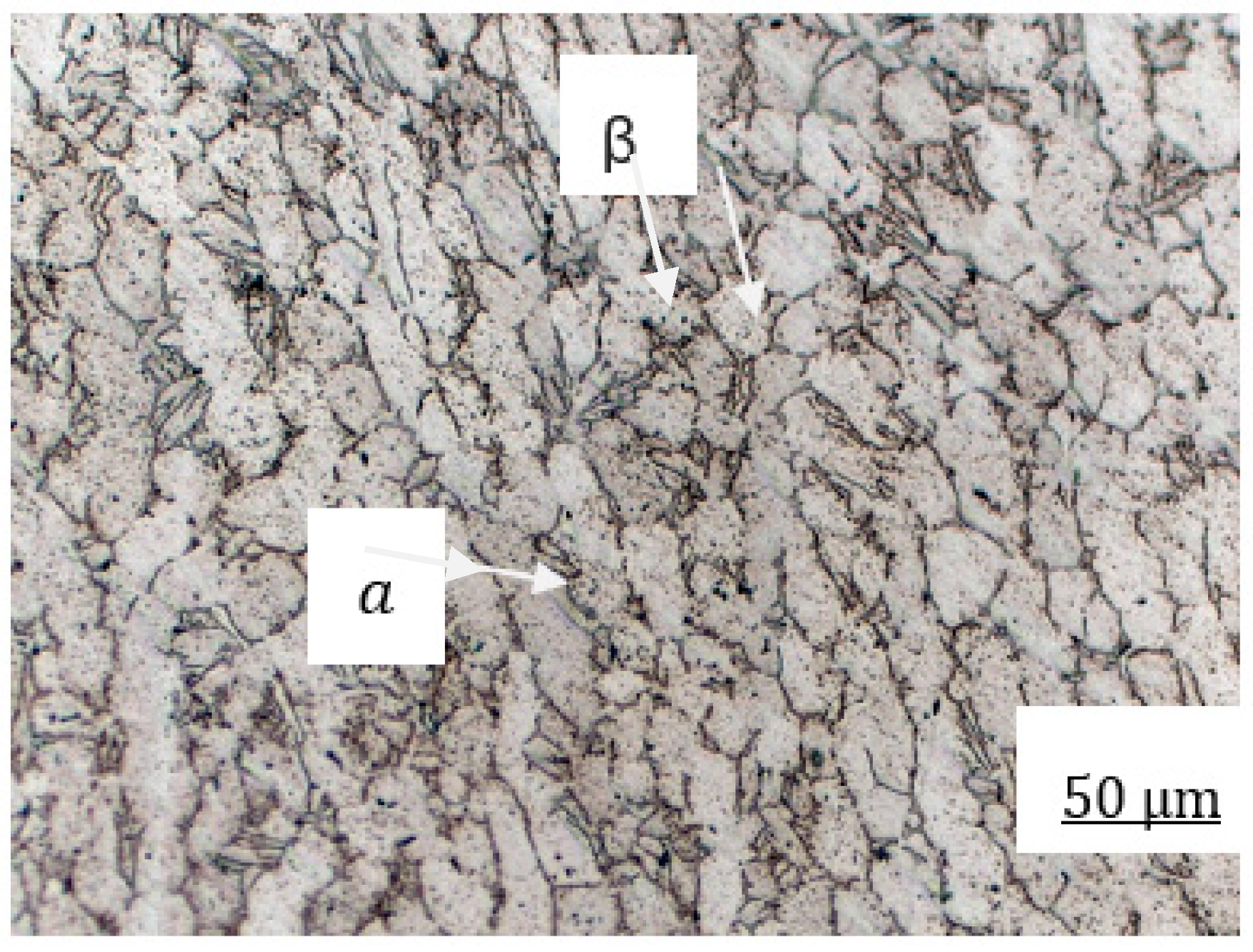

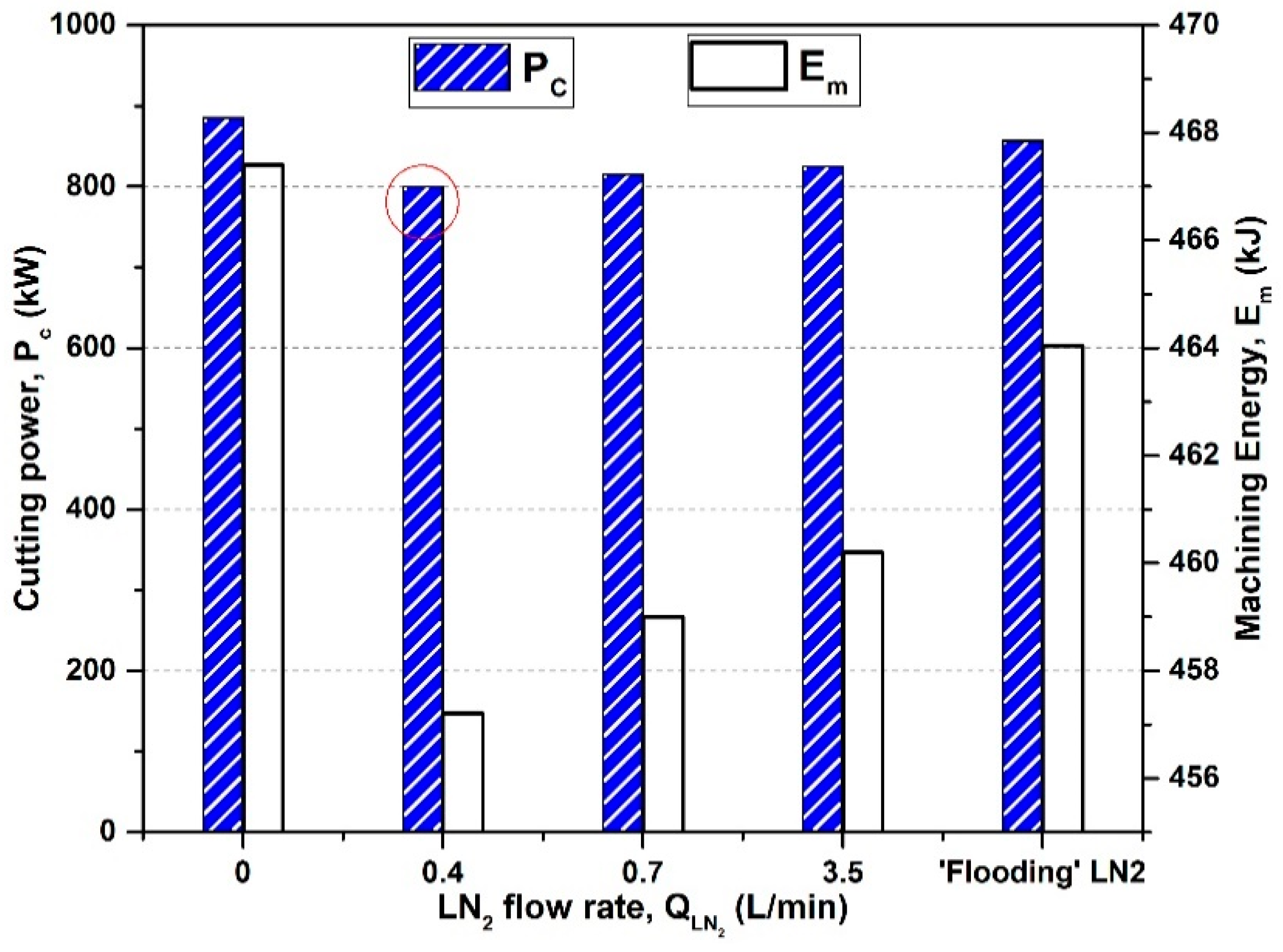

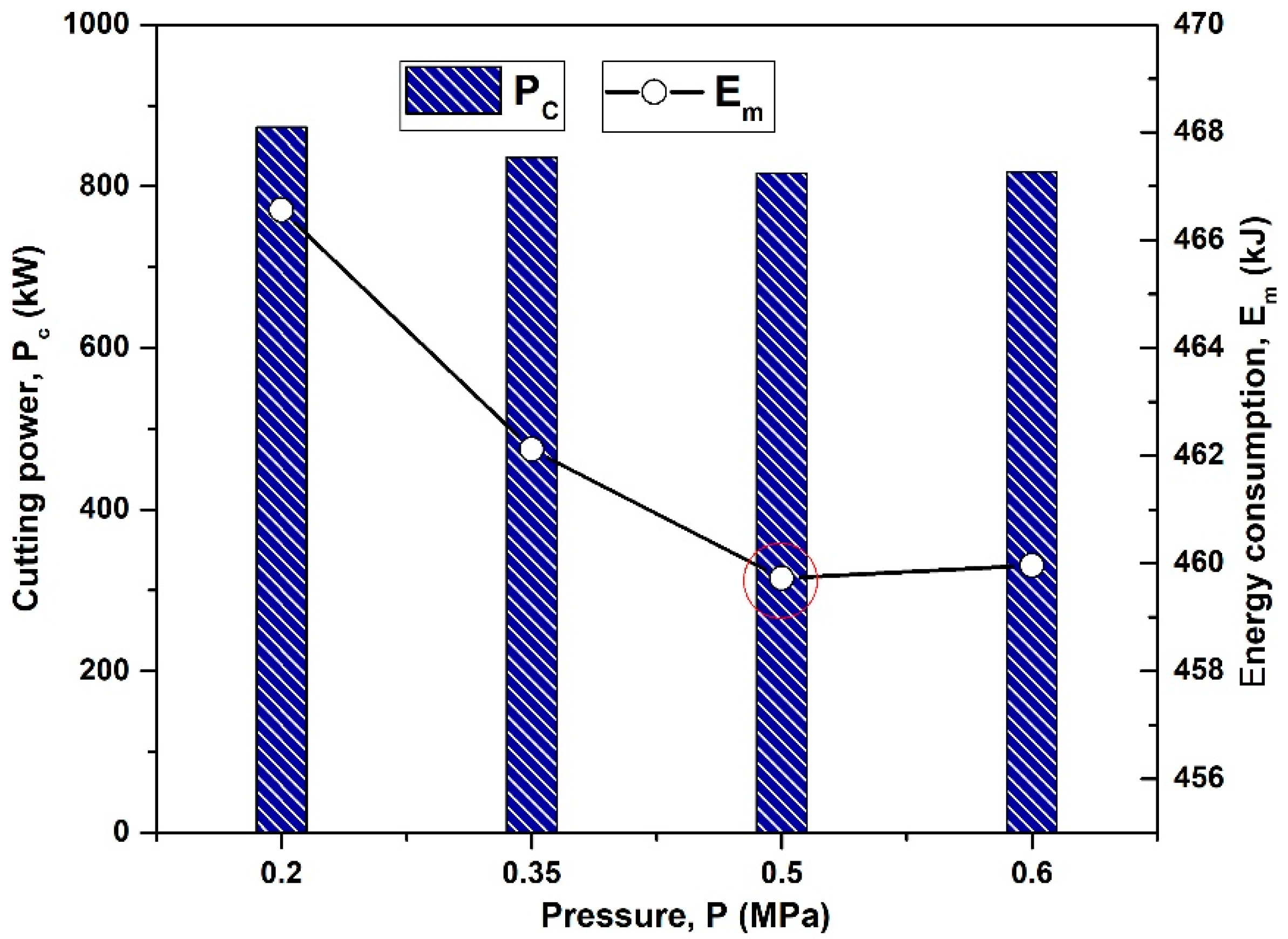

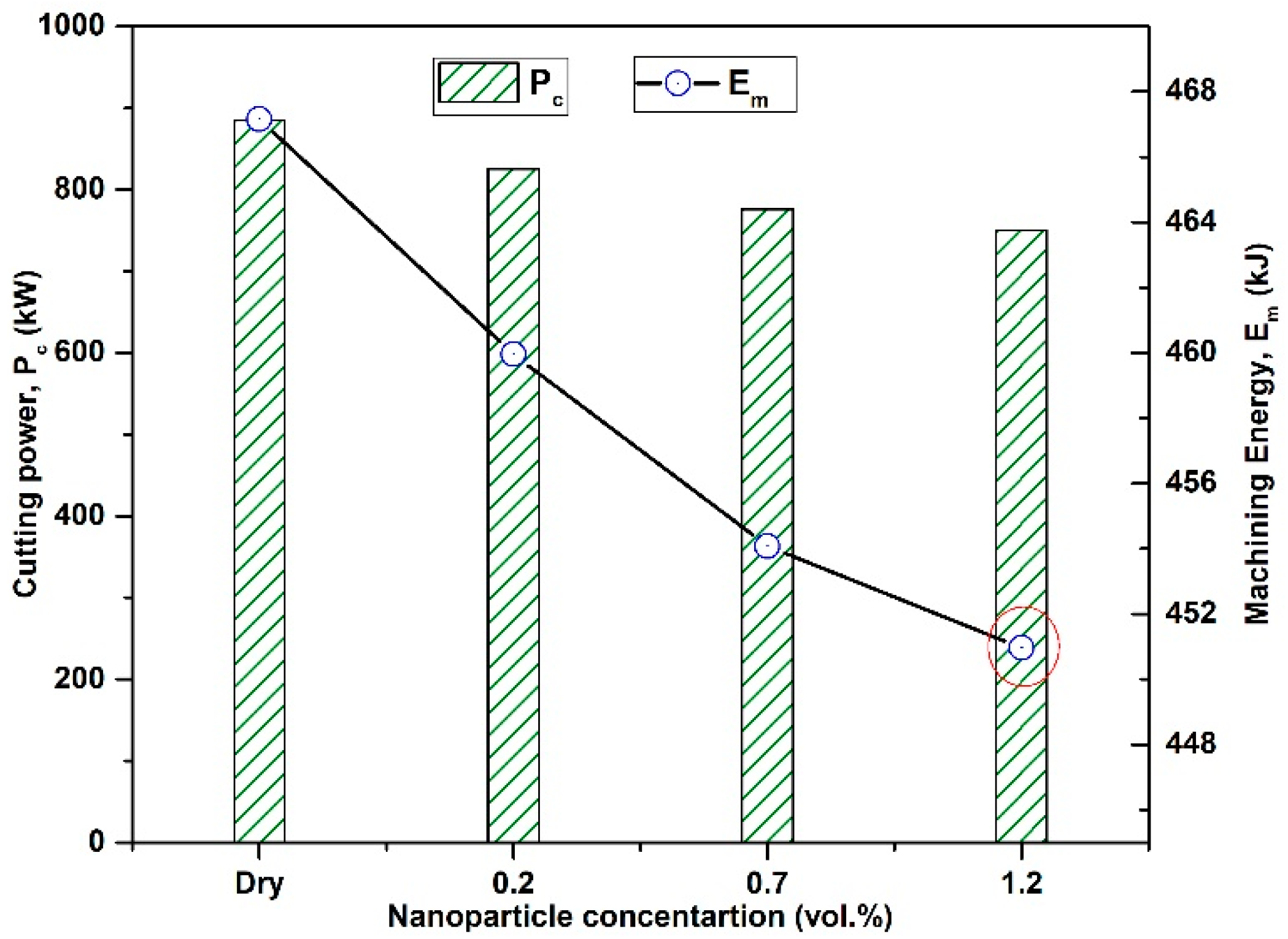
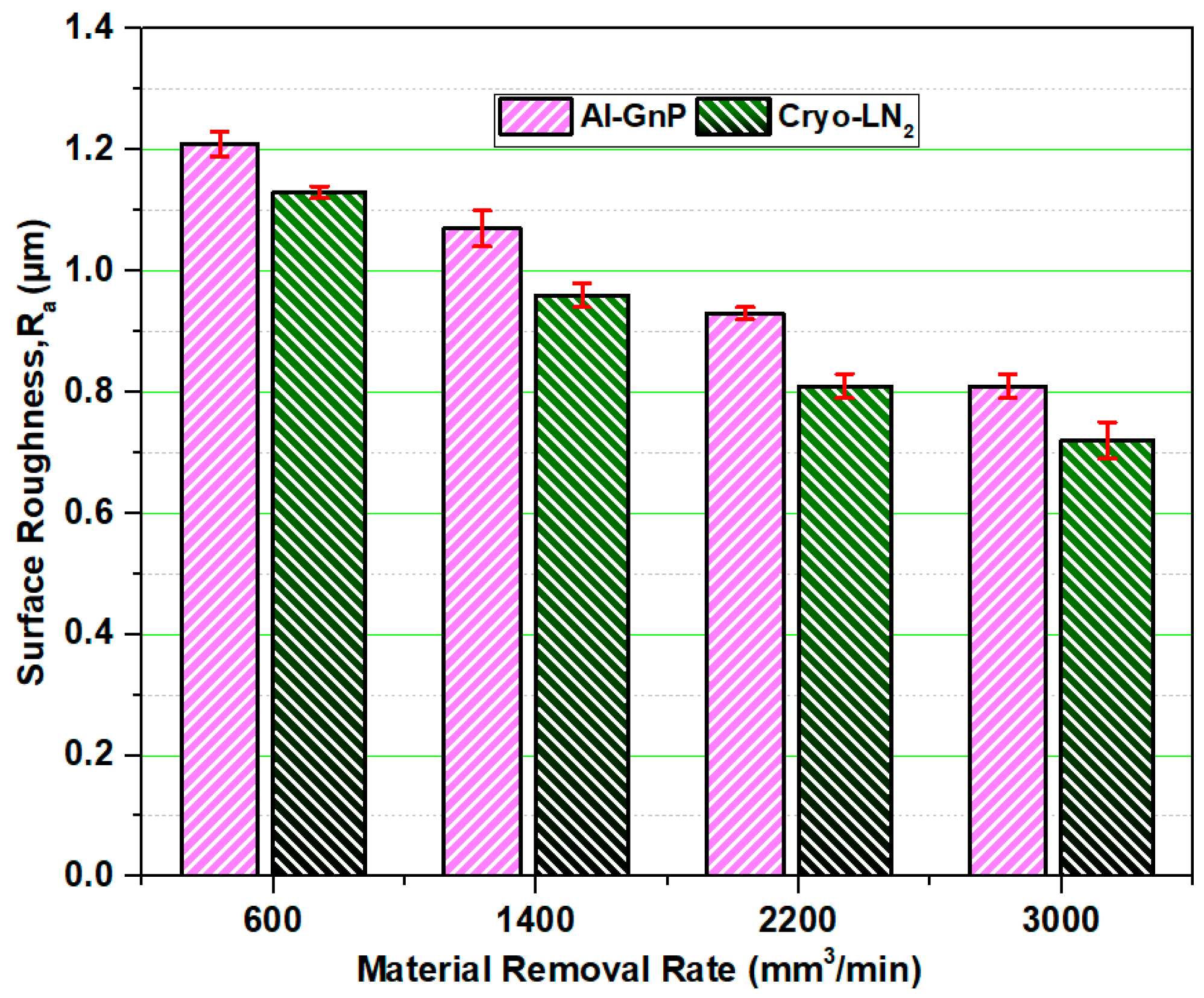

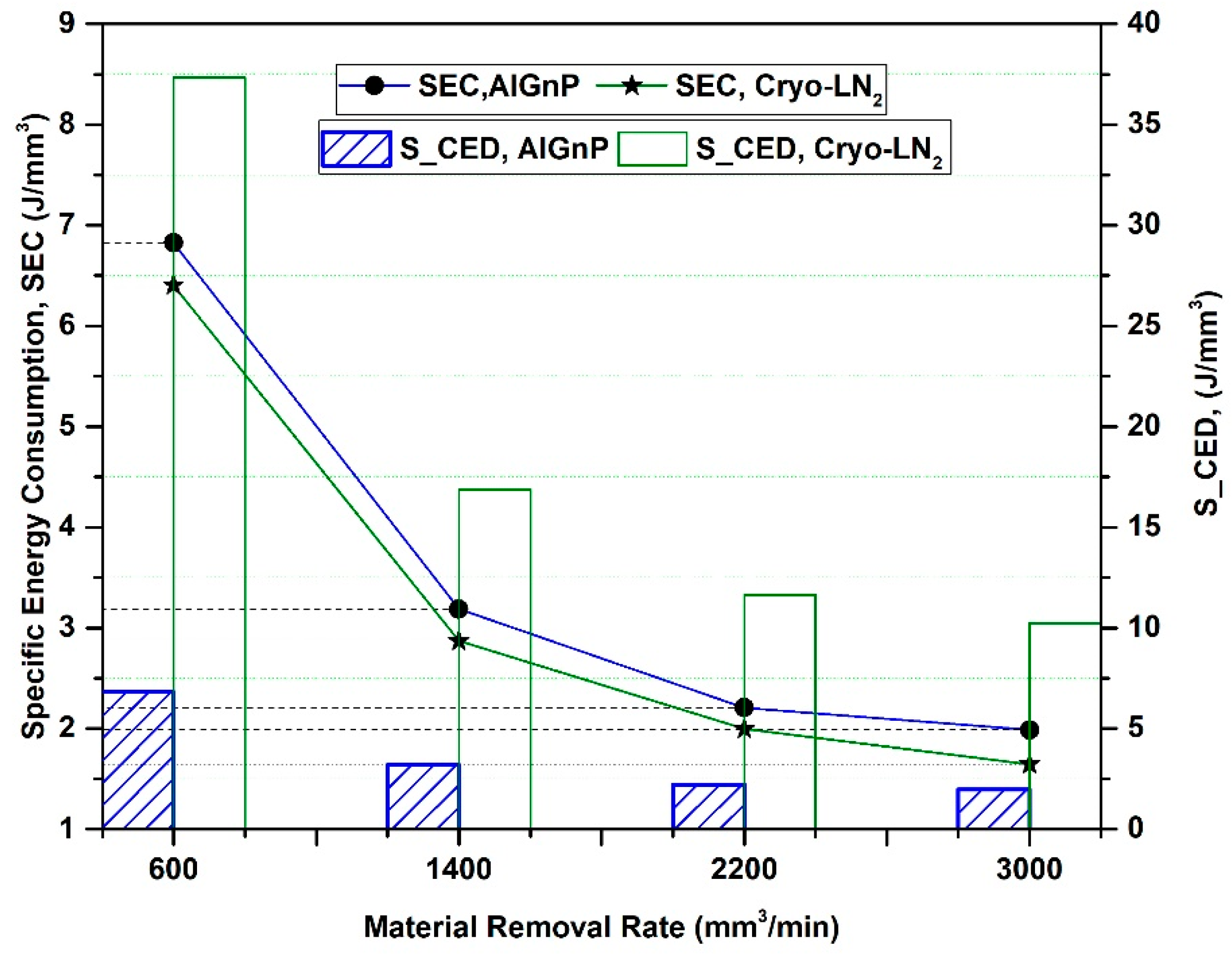

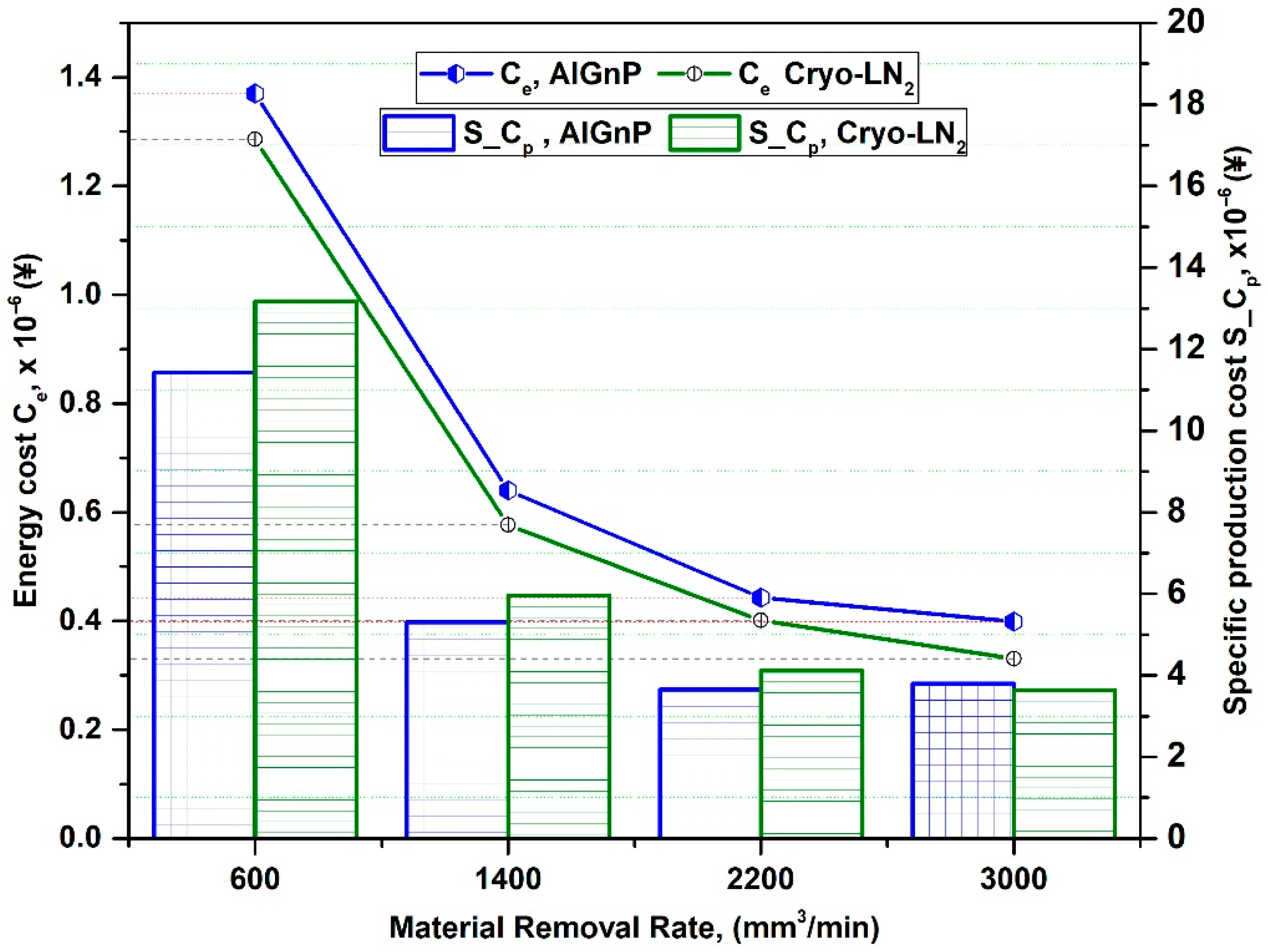
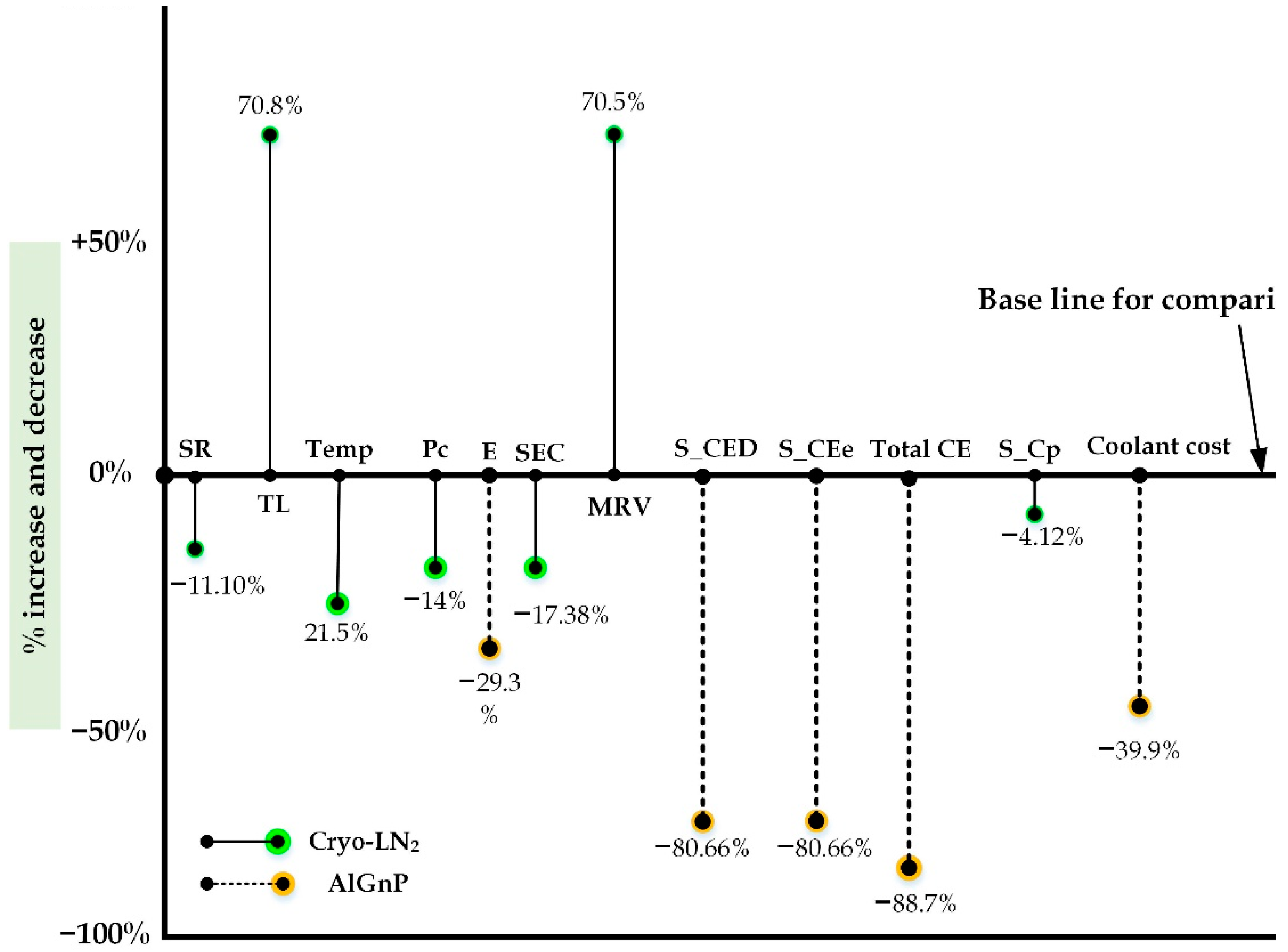
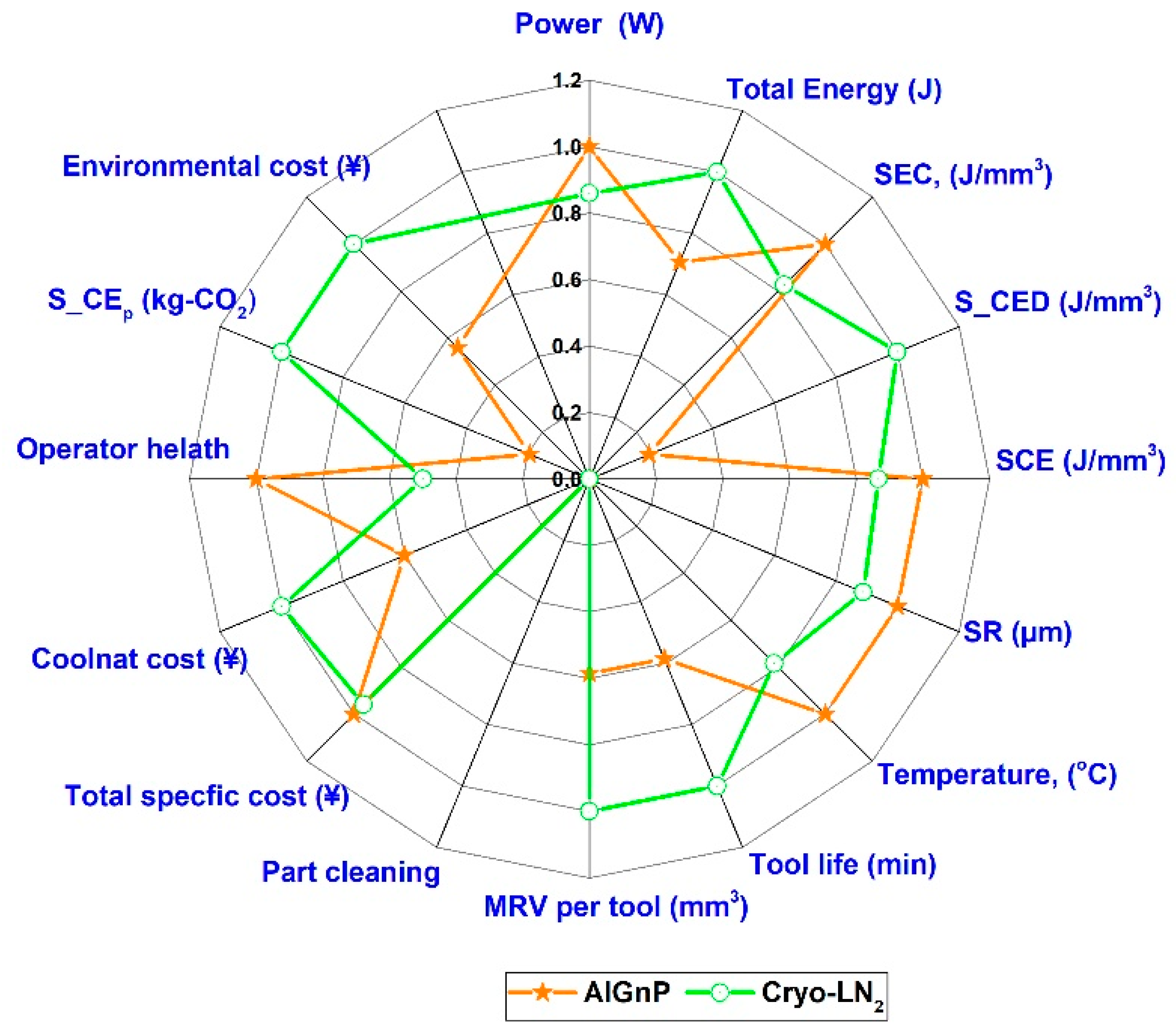
| Ti | V | Al | C | Fe | H | N | Y |
|---|---|---|---|---|---|---|---|
| Balance | 4.02 | 5.85 | 0.01 | 0.20 | 0.0023 | 0.007 | <0.0048 |
| Parameter (s) | Units | Value | Reference/Remarks |
|---|---|---|---|
| W | 350 | Idle power (measured) | |
| W | 800 | MQL system power (measured) | |
| s | 30 | Idle time | |
| s | 20 | Air cutting time | |
| s | 60 | Tool change time per part | |
| s | Lubrication time | ||
| L/min | 0.4 | LN2 flow rate | |
| mL/s | 300 | Consumption rate of MQL oil | |
| MJ/L | 2.6 | Embodied energy LN2 [31]. | |
| kJ/L | 1.37 | Embodied energy (MQL oil) [32] | |
| kg-CO2/GJ | 258.2 | CES of Nanjing electric grid [33] | |
| kg-CO2/L | 0.11 | Carbon footprints of MQL oil [34] | |
| kg-CO2/L | 1.30 | Carbon footprints of LN2 [35] | |
| CNY/kWh | 0.723 | Cost of electricity [12] | |
| CNY/L | 100 | Cost of the cutting fluid | |
| CNY/L | 1 | Cost of the LN2 |
Publisher’s Note: MDPI stays neutral with regard to jurisdictional claims in published maps and institutional affiliations. |
© 2021 by the authors. Licensee MDPI, Basel, Switzerland. This article is an open access article distributed under the terms and conditions of the Creative Commons Attribution (CC BY) license (http://creativecommons.org/licenses/by/4.0/).
Share and Cite
Khan, A.M.; Anwar, S.; Jamil, M.; Nasr, M.M.; Gupta, M.K.; Saleh, M.; Ahmad, S.; Mia, M. Energy, Environmental, Economic, and Technological Analysis of Al-GnP Nanofluid- and Cryogenic LN2-Assisted Sustainable Machining of Ti-6Al-4V Alloy. Metals 2021, 11, 88. https://doi.org/10.3390/met11010088
Khan AM, Anwar S, Jamil M, Nasr MM, Gupta MK, Saleh M, Ahmad S, Mia M. Energy, Environmental, Economic, and Technological Analysis of Al-GnP Nanofluid- and Cryogenic LN2-Assisted Sustainable Machining of Ti-6Al-4V Alloy. Metals. 2021; 11(1):88. https://doi.org/10.3390/met11010088
Chicago/Turabian StyleKhan, Aqib Mashood, Saqib Anwar, Muhammad Jamil, Mustafa M. Nasr, Munish Kumar Gupta, Mustafa Saleh, Shafiq Ahmad, and Mozammel Mia. 2021. "Energy, Environmental, Economic, and Technological Analysis of Al-GnP Nanofluid- and Cryogenic LN2-Assisted Sustainable Machining of Ti-6Al-4V Alloy" Metals 11, no. 1: 88. https://doi.org/10.3390/met11010088
APA StyleKhan, A. M., Anwar, S., Jamil, M., Nasr, M. M., Gupta, M. K., Saleh, M., Ahmad, S., & Mia, M. (2021). Energy, Environmental, Economic, and Technological Analysis of Al-GnP Nanofluid- and Cryogenic LN2-Assisted Sustainable Machining of Ti-6Al-4V Alloy. Metals, 11(1), 88. https://doi.org/10.3390/met11010088










